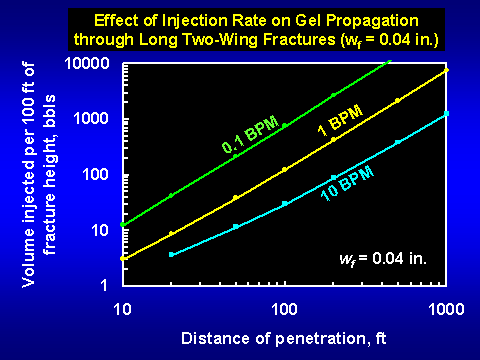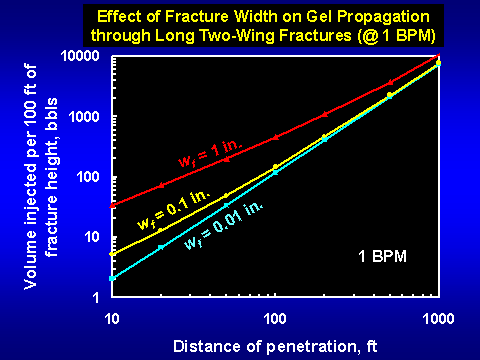Individual Fractures that cause Channelling from Injectors to Producers
Problem 9 in Table 1

Gel treatments currently provide the most effective means to reduce channeling through fractures.4,57-59 Except in narrow fractures (i.e., fracture widths less than 0.02 in.), extruded gels have a placement advantage over conventional gelant treatments when treating channeling through fractures. To explain, during conventional gel treatments, a fluid gelant solution typically flows into a reservoir through both the porous rock and the fractures. After placement, chemical reactions (i.e., gelation) cause an immobile gel to form. During gelant injection, fluid velocities in the fracture are usually large enough that viscous forces dominate over gravity forces.60 Consequently, for small-volume treatments, the gelant front is not greatly distorted by gravity during gelant injection. However, after gelant injection stops, a small density difference (e.g., 1%) between the gelant and the displaced reservoir fluids allows gravity to rapidly drain gelant from at least the upper part of the fracture.60 Generally, gelation times cannot be controlled well enough to prevent gravity segregation in the time between gelant injection and gelation.
Alternative to conventional gelant treatments, formed (preformed) gels can be extruded through fractures. Since these gels are 103 to 105 times mores viscous than gelants, gravity segregation for gels is much less important than for gelants. For some of the most successful treatments in fractured reservoirs, formed gels were extruded through fractures during most of the placement process.11,57-59
The extrusion properties of a Cr(III)-acetate-HPAM (chromium(III)-carboxylate/acrylamide-polymer) gel have been characterized as a function of injection rate and time and fracture width and length.39 Gels concentrate or dehydrate during extrusion through fractures. During flow in a fracture, the rate of dehydration of these gels varies inversely with the square root of time. This fact allows gel propagation along fractures to be predicted.39,61 (See Figs. 2 and 3 for propagation of a Cr(III)-acetate-HPAM gel in a vertical fracture of fixed height.) To maximize gel penetration along fractures, the highest practical injection rate should be used. However, in wide fractures or near the end of gel injection, gel dehydration may be desirable to form stronger and rigid gels that are less likely to washout after placement. In these applications, reduced injection rates may be appropriate. In single, wide (i.e., >0.5 in.) vertical fractures (of fixed height) where short distances of penetration are needed, the gel volume required increases roughly with the distance of penetration. In single vertical fractures (of fixed height) with narrow to moderate widths (i.e. 0.02 to 0.5 in.), the required gel volume increases roughly with the distance of penetration raised to the 1.5 power. A rule of thumb derived from this latter behavior is that doubling the distance of penetration along a given fracture (of narrow or moderate width) requires tripling the volume of injected gel.


A minimum pressure gradient is required to extrude a given gel through a fracture.39 After this minimum pressure gradient is met, the pressure gradient during gel extrusion is insensitive to the flow rate. The pressure gradient required for gel extrusion varies inversely with the square of fracture width.39 The volume of gel that can be injected depends critically on fracture width and gel properties (i.e., gel composition and rigidity). For a typical Cr(III)-acetate-HPAM gel (containing 0.5% polymer), a 2 psi/ft pressure gradient was noted during extrusion through a 0.1-in.-wide fracture.39 Therefore, in field applications, knowledge and/or estimation of fracture widths is important for deciding the composition and properties of the gel to be injected.
For interwell channeling, the effective average width of the most direct fracture can be estimated from interwell tracer tests.62,63 Tester et al.62 suggested that the best estimate of the480lume of a fracture path is provided by the modal volume (i.e., the volume associated with the peak concentration in the produced tracer distribution). The interwell tracer time (t in days) associated with this peak concentration can be use to estimate effective average fracture width (wf in inches)63.
where Lf is the injector-producer well separation (in feet), μ is tracer fluid viscosity (in cp), and Δp is the downhole interwell pressure drop (in psi).
For some applications where wide fractures or large vugs are present, gels alone may not provide sufficient mechanical strength and flow resistance to plug the channel. In these cases, particulate matter (sand, cellophane, fibers, nut shells, etc.) can be added to increase the mechanical strength and plugging characteristics of the gel.64-66
Gel jobs to treat individual fractures that cause channeling from injectors to producers can be applied in either injection or production wells.